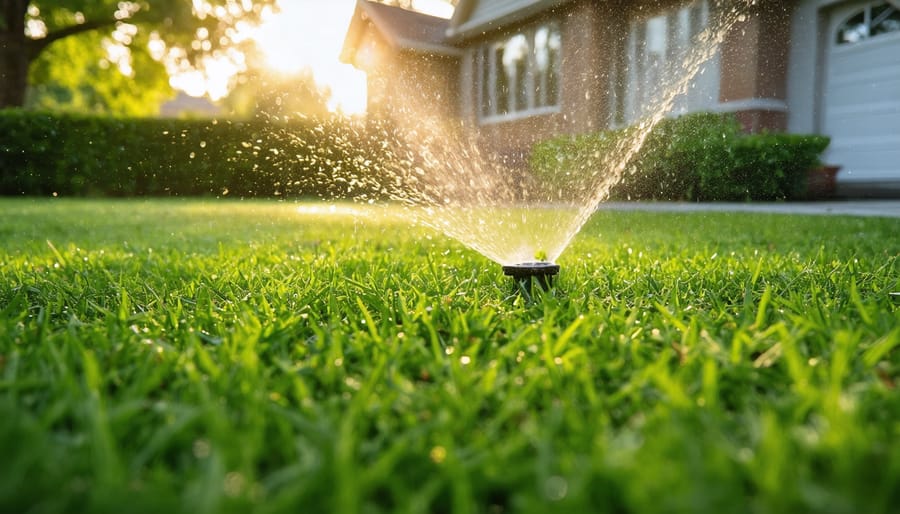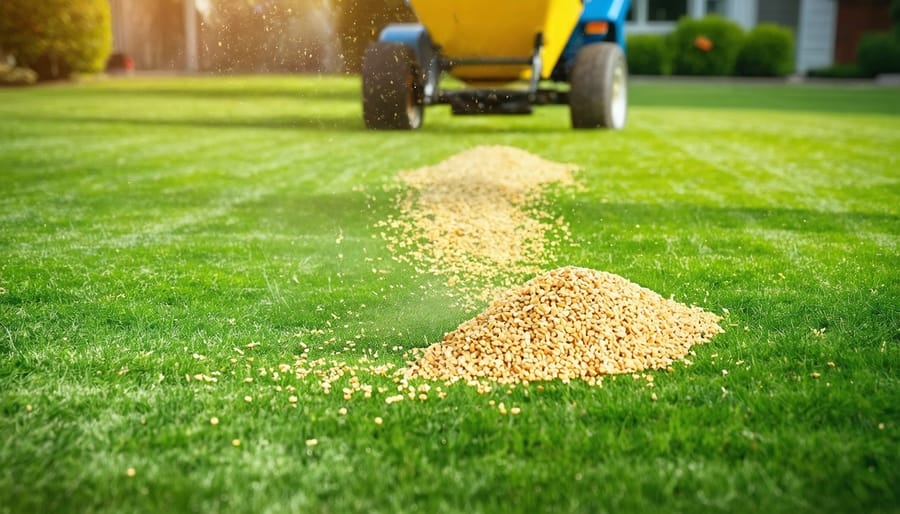Transform your lawn maintenance routine with plant growth regulators (PGRs) – the professional groundskeeper’s secret weapon for achieving that perfect, low-maintenance turf. These innovative compounds work alongside your regular spring lawn fertilization to reduce mowing frequency by up to 50% while promoting denser, healthier grass growth.
Unlike traditional lawn care products, growth regulators specifically target the grass’s hormonal system, redirecting energy from vertical growth into root development and lateral spread. This results in a more resilient lawn that requires less water, fewer mowing sessions, and demonstrates improved resistance to common turf stresses like drought and disease.
For eco-conscious homeowners seeking a sustainable approach to lawn maintenance, PGRs offer a practical solution that reduces fuel consumption from frequent mowing while maintaining professional-quality results. Whether you’re managing a sprawling residential lawn or a compact urban yard, these advanced turf management tools deliver consistent results throughout the growing season.
Understanding Lawn Growth Regulators
The Science Behind Growth Regulation
Growth regulators work by interacting with specific plant hormones, primarily gibberellins, which are responsible for cell elongation and vertical growth in grass. When applied, these chemicals temporarily suppress the production of gibberellins, effectively slowing down the upward growth of grass blades while allowing the plant to focus energy on lateral growth and root development.
Think of it as redirecting your lawn’s energy resources. Instead of putting all its effort into growing taller, your grass can strengthen its root system and develop denser, healthier turf. This process doesn’t harm the grass; rather, it modifies its natural growth pattern for a period of 4-6 weeks, depending on the product used.
The active ingredients in most lawn growth regulators, such as trinexapac-ethyl or prohexadione-calcium, are absorbed through the grass blades and transported throughout the plant. These compounds work at the cellular level, inhibiting the late stages of gibberellin biosynthesis. While this might sound complex, the result is straightforward: your grass grows more slowly upward while maintaining its natural green color and health.
Interestingly, this process can also enhance your lawn’s stress tolerance. When grass plants redirect energy from vertical growth, they become more resilient to drought, heat, and other environmental stressors, making growth regulators particularly valuable during challenging weather conditions.
Types of Growth Regulators
Lawn growth regulators generally fall into two main categories: Type I and Type II regulators, each working differently to manage your lawn’s growth patterns. Type I regulators, also known as Class A regulators, work by inhibiting cell elongation. These are particularly effective for maintaining a neat, compact lawn without frequent mowing. Popular Type I products include trinexapac-ethyl and prohexadione-calcium, which are especially useful for controlling vertical growth in cool-season grasses.
Type II regulators, or Class B regulators, function by preventing cell division in grass plants. These are typically used when you need more comprehensive growth control, as they affect both vertical and lateral growth. Products containing mefluidide or ethephon fall into this category and are often chosen for their longer-lasting effects.
There’s also a newer category of “hybrid” regulators that combine different active ingredients to provide more balanced growth control. These modern formulations often include additional benefits like improved stress tolerance and root development, making them increasingly popular among homeowners who want multiple benefits from a single application.
When choosing between types, consider your specific grass variety and maintenance goals. Cool-season grasses typically respond better to Type I regulators, while warm-season grasses might benefit more from Type II or hybrid formulations. Always start with the recommended application rate and adjust based on your lawn’s response.

Benefits for Spring Lawn Care
Reduced Mowing Frequency
One of the most appealing benefits of using lawn growth regulators is the significant reduction in mowing frequency. While traditional lawn care often requires weekly mowing during peak growing seasons, applying growth regulators can cut this requirement by 30-50%. This means you might only need to mow every 10-14 days instead of weekly, saving both time and energy while maintaining lawn health.
The reduced mowing frequency doesn’t come at the expense of your lawn’s appearance. Growth regulators work by suppressing vertical growth while encouraging lateral growth and root development. This results in a denser, more uniform lawn that stays at an ideal height for longer periods. You’ll notice that grass blades grow more slowly but maintain their vibrant color and thickness.
For busy homeowners or those managing large properties, this time-saving benefit is particularly valuable during spring and summer when grass typically grows most vigorously. The reduction in mowing not only saves time but also decreases fuel consumption and equipment wear, making it an environmentally friendly choice for sustainable lawn care.
Enhanced Root Development
One of the most remarkable benefits of lawn growth regulators is their positive impact on root development. While these products slow down above-ground growth, they actually encourage your grass to direct more energy into developing a stronger, deeper root system. This enhanced root development leads to a more drought-resistant and resilient lawn that can better withstand stress from heat, foot traffic, and disease.
When growth regulators are applied, the plant redirects its resources from leaf elongation to root expansion. This results in increased root mass and depth, allowing your grass to access water and nutrients from deeper soil layers. The improved root network also helps stabilize soil structure and reduces erosion, contributing to overall lawn health.
Stronger roots mean your lawn will require less frequent watering, as it can better utilize available moisture. This water efficiency not only promotes sustainable gardening practices but also helps reduce your water bills. Additionally, the enhanced root system provides better nutrient uptake, potentially reducing the need for frequent fertilizer applications.
For best results, consider applying growth regulators when your grass is actively growing but before periods of anticipated stress, such as summer heat waves. This timing allows the root system to establish itself fully and prepare for challenging conditions.

Stress Tolerance
One of the most significant advantages of using lawn growth regulators during spring is their ability to enhance your lawn’s stress tolerance. When applied correctly, these regulators help grass develop stronger root systems and improved drought resistance, leading to notable water conservation benefits. Think of it as giving your lawn a protective shield against environmental challenges.
During spring transition, your grass is particularly vulnerable to various stresses, including temperature fluctuations and changing moisture levels. Growth regulators help by redirecting the plant’s energy from excessive top growth to strengthening its foundation. This improved root development is crucial for summer stress preparation.
Treated lawns typically show better resistance to foot traffic, disease pressure, and extreme weather conditions. The regulated growth pattern allows grass to maintain its density without becoming weak or stretched, resulting in a more resilient turf. Many homeowners report that their regulated lawns bounce back more quickly from stress events and maintain better color during challenging periods.
Remember that while growth regulators enhance stress tolerance, they work best as part of a comprehensive lawn care program that includes proper watering, mowing, and fertilization practices.
Application Best Practices
Timing Your Application
The key to successful growth regulator application lies in perfect spring application timing. For best results, wait until your lawn has experienced its initial spring growth surge and has been mowed at least twice. This typically occurs when soil temperatures consistently reach 55-60°F (13-16°C).
Start monitoring your lawn in early spring, usually around the time when you notice consistent new growth. The ideal application window is when your grass is actively growing but before it hits its peak growth phase. In most regions, this sweet spot falls between mid-April and early May, depending on your local climate.
Avoid applying growth regulators during periods of drought stress or when rain is expected within 24 hours. Morning applications are best, giving the product time to absorb properly before evening dew sets in. For optimal results, apply when the grass is dry but the soil is slightly moist from previous rainfall or light irrigation.
Remember that timing varies slightly depending on your grass type. Cool-season grasses like Kentucky Bluegrass might be ready for treatment earlier than warm-season varieties such as Bermuda grass. Always check your local weather patterns and soil temperatures before making the final decision on application timing.

Application Methods
Applying lawn growth regulators correctly is key to achieving the best results. Start by mowing your lawn to its recommended height and removing any debris. Choose a calm day with no rain forecast for at least 24 hours to ensure proper absorption.
Mix the growth regulator according to the product label instructions, typically using a backpack sprayer or hand-held sprayer for application. Calibrate your sprayer beforehand to ensure even coverage – a common ratio is about 1 gallon of mixture per 1,000 square feet of lawn.
For the most effective application:
1. Divide your lawn into manageable sections
2. Start spraying from one corner, walking at a steady pace
3. Overlap spray patterns slightly to avoid missing spots
4. Apply in two directions (north-south, then east-west) for even coverage
Always wear appropriate protective gear, including gloves, long sleeves, and closed-toe shoes. Apply in the early morning or late afternoon to minimize product evaporation. Keep children and pets off the treated area until it’s completely dry, usually about 4 hours.
Monitor your lawn’s response over the next few days. You should notice reduced mowing needs within 2-3 weeks. Most applications remain effective for 4-6 weeks, depending on weather conditions and grass type. Mark your calendar for reapplication based on the product’s recommended timing.
Safety and Environmental Considerations
While lawn growth regulators are generally safe when used correctly, it’s essential to follow proper safety protocols and consider environmental impacts. Always wear protective gear, including gloves, long sleeves, and closed-toe shoes when applying these products. Keep children and pets off treated areas until the application has completely dried, typically for about 24 hours.
From an environmental perspective, modern lawn growth regulators have come a long way in terms of safety. Most current formulations break down naturally in the soil and don’t pose significant risks to beneficial insects or soil microorganisms. However, it’s crucial to avoid over-application or treating areas near water sources, as runoff can affect aquatic ecosystems.
To minimize environmental impact, consider these best practices: Apply during calm weather conditions to prevent drift, avoid application before heavy rain, and only treat areas that genuinely need growth regulation. Many homeowners find success by using growth regulators as part of an integrated lawn care approach, combining them with natural maintenance practices like proper mowing height and organic fertilization.
Storage safety is equally important. Keep growth regulators in their original containers, stored in a cool, dry place away from direct sunlight and out of reach of children and pets. Always dispose of empty containers according to local regulations and never reuse them for other purposes.
Common Mistakes to Avoid
When using lawn growth regulators, even experienced gardeners can make mistakes that impact their effectiveness. Here are the key pitfalls to avoid and how to prevent them.
One common mistake is applying growth regulators to stressed grass. Whether from drought, disease, or recent mowing damage, stressed lawns need time to recover before treatment. Wait until your lawn is healthy and actively growing before application.
Incorrect timing can significantly reduce effectiveness. Applying too early in spring when grass isn’t actively growing, or too late in fall when growth naturally slows, won’t yield optimal results. Similarly, applying during extreme weather conditions can affect absorption and effectiveness.
Many gardeners overlook the importance of proper calibration and end up with uneven application. This leads to patchy growth patterns where some areas grow normally while others are overly regulated. Always measure your lawn area accurately and follow product dilution rates precisely.
Another frequent error is mowing at the wrong height before application. For best results, mow your lawn at regular height 1-2 days before applying growth regulators. Cutting too short can stress the grass and reduce the product’s effectiveness.
Failing to maintain regular watering schedules after application is also problematic. While growth regulators reduce mowing needs, they don’t reduce the lawn’s water requirements. Maintain consistent irrigation to support healthy growth.
Lastly, don’t forget to reapply at recommended intervals. Many gardeners wait too long between applications, leading to irregular growth patterns. Mark your calendar and stick to the recommended application schedule for consistent results.
Lawn growth regulators represent a valuable tool in modern lawn care, offering a sustainable approach to maintaining a beautiful, healthy lawn while reducing maintenance demands. By understanding how these products work and implementing them correctly, you can achieve remarkable results with less effort and environmental impact. Remember to always start with a soil test and choose a regulator that matches your grass type and climate conditions. Proper timing, especially during the spring growing season, is crucial for optimal results.
While growth regulators require an initial investment and careful application, the benefits – including reduced mowing frequency, improved grass density, and enhanced stress tolerance – make them worth considering for any serious lawn enthusiast. For best results, combine growth regulators with other sustainable lawn care practices such as proper watering, appropriate fertilization, and regular maintenance. Whether you’re looking to save time, improve your lawn’s appearance, or adopt more environmentally friendly practices, lawn growth regulators can be an excellent addition to your lawn care arsenal. Just remember to start with a small area, follow application instructions carefully, and adjust your approach based on your lawn’s specific needs and response.




